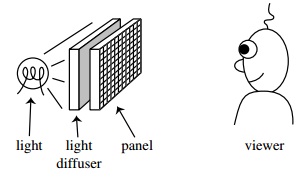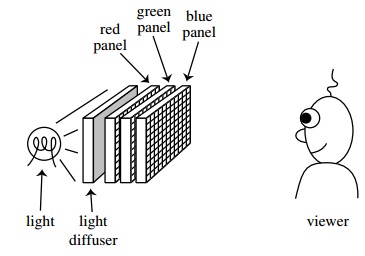An inventor has freshly developed a new display device: it is a transparent panel with a rectangular array of square pixels. The panel is tinted with special ink that permits each pixel to range from totally transparent to transmitting only the color of the ink. Each pixel has an 8-bit value. For illustration, if the ink is blue then a pixel value of 0 would be completely transparent, 255 totally blue (just blue light transmitted) and 100 a light blue.

The inventor has freshly found that he can make the special ink in any color he likes, however that each panel can be tinted with only one of these colors. He suggests using three inks in three panels to make a 24-bit color display: a red-tinted panel, a green-tinted panel and a blue-tinted panel will be stacked up to make a full-color display (see figure). A value of (0; 0; 0) will therefore be white (transparent), (255; 0; 0) red and (255; 255; 255) black.

Question 1: Describe why this will not work.
Question 2: Change the three-panel design so that it will work.
Question 3: In common with other 24-bit ‘full-color’ displays (for illustration CRT and LCD), your display can’t display every color which a human can perceive. Why not?
Question 4: In image compression we utilize three different methods to compress pixel data:
a) Mapping the pixel values to some other set of values.
b) Quantizing those values.
c) Symbol encoding the resultant values.
Describe each method, why it helps us to compress the image, and whether (giving reasons) the resultant image noticeably differs.